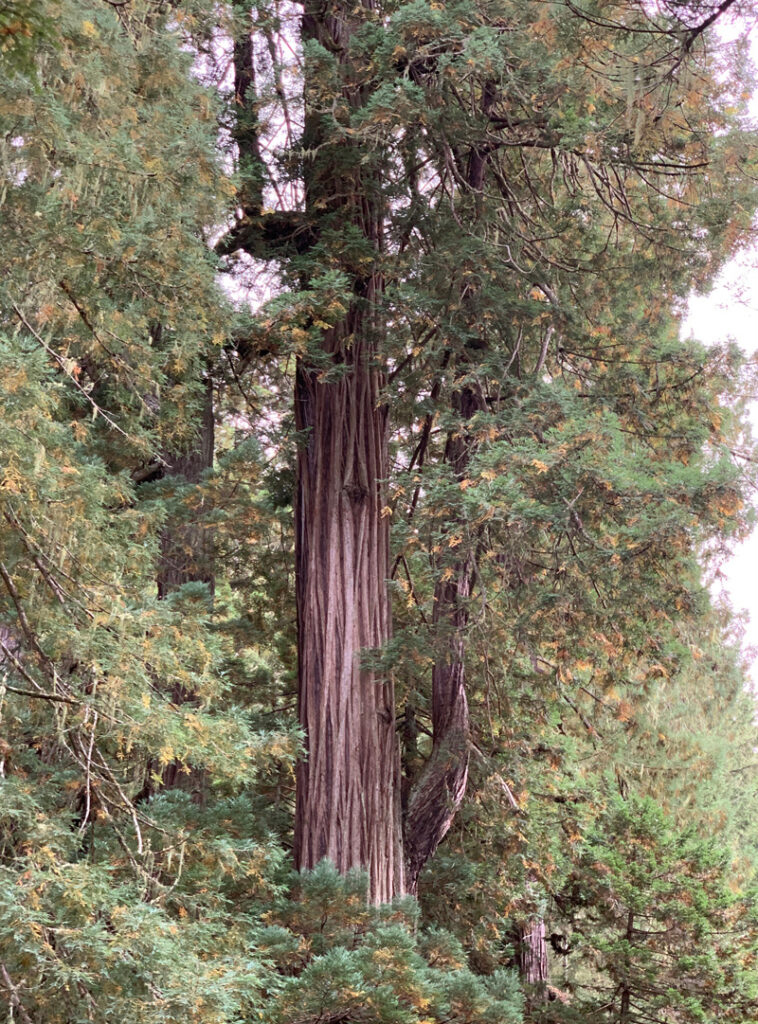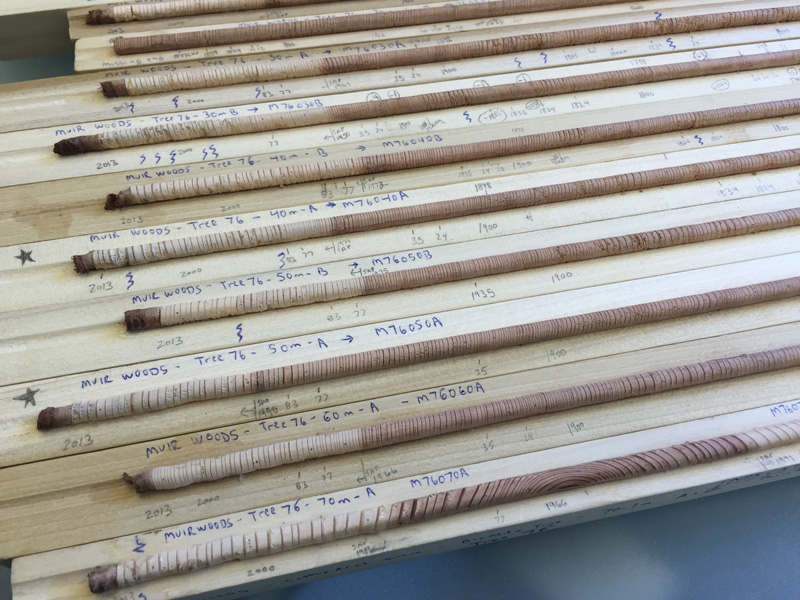Sequoia sempervirens, also known as coast redwoods, may be the tallest trees in the world, but just the tiniest samples of their wood can reveal the past. Researchers recently analyzed thousands of pencil-width cores extracted from living trees and deadwood to construct a set of annually dated tree ring chronologies for coast redwood, the first such database of its kind. These records, which stretch back to the 4th century, will allow scientists to pinpoint the precise timing of climatic changes, earthquakes, and other environmental phenomena.
Climbing for Science
Between 2005 and 2021, researchers working in California and Oregon collected tree cores from hundreds of coast redwoods. Each extraction was a massive undertaking, said Allyson Carroll, a dendrochronologist at California State Polytechnic University, Humboldt, who led the new analysis. That’s because rather than just walking up to a tree and collecting a single core, as is commonly done in dendrochronological studies, the researchers donned climbing gear and ascended via free-hanging ropes to collect cores every 10 meters along a tree’s trunk.

Acrophobia is clearly a foreign concept in this line of work—the redwoods towered up to 116 meters (380 feet) tall.
It could take the better part of a day to rig just one tree with ropes and collect cores from it, said Steve Sillett, a botanist at California State Polytechnic University, Humboldt, who did a lot of the climbing. Each core, measuring 0.5 centimeter (0.2 inch) in diameter, was drilled, by hand, using an instrument called an increment borer. “It’s a lot of physical work,” Sillett said. “By the end of the day, our arms are sore.”
To transport the cores safely back to the ground, the team placed them in rigid cases that they nestled within drawstring bags. But extracting a core and maneuvering it into a case is a delicate dance, particularly when a core is brittle, Sillett said. “Sometimes they do drop, and it’s excruciating.”
A Puzzle in Wood
Carroll spearheaded the analysis of the team’s roughly 6,000 cores. Each cylindrical sample revealed a sequence of tree rings, and Carroll’s first step was to crossmatch the sequences obtained at different heights from a single tree. That was harder than it sounds, said Carroll, because the rings of Sequoia sempervirens don’t always grow uniformly along a tree’s entire vertical extent.
“I can’t imagine the complexity of the puzzle that they had to put together.”
It’s relatively common in these trees that a ring just disappears at some point, said Evan Larson, a dendrochronologist at the University of Wisconsin–Platteville, who was not involved in the study. Sequences from the same coast redwood can have huge discrepancies in their numbers of rings, he said. “Sometimes it’s a dozen or more.”
For each of the 278 trees sampled, Carroll used visual and computer-aided matching to compare patterns of ring widths and determine a complete growth sequence. She ascribed a calendar year to each tree ring by identifying sequences of so-called marker years—rings that are characteristically thicker or thinner or otherwise altered and correspond to independently dated events such as droughts or fires—and then counting forward or backward in time.

In all, Carroll tabulated over 1.2 million rings. Keeping all of those measurements straight was no doubt an enormous amount of work, said Bryan Black, a dendrochronologist at the University of Arizona in Tucson, who was not involved in the research. “I can’t imagine the complexity of the puzzle that they had to put together.”
Carroll next stitched together growth sequences from different trees growing within a kilometer or so of one another. It’s most valid to compare trees growing in geographic proximity, Carroll said, because they experience a similar climate, which is a major driver of ring growth.
Carroll divided the team’s sample of trees into 47 regions and assembled a ring chronology for each region. Those records ranged in length from 86 to 1,687 rings, with the oldest ring—from a tree in Redwood National Park, near Orick, Calif.—corresponding to the year 328 CE, the team reported in Dendrochronologia.
Sleuthing for an Earthquake
Coast redwoods have long stood sentry in a complex ecosystem shaped by fire, drought, and fog. Many of those environmental drivers can be recorded in tree rings, Larson said, and redwoods can accordingly provide a record of long-term climate change. The new chronologies—more than half of which stretch back at least 500 years—are critical for determining when specific environmental changes occurred, Larson said. “There’s the ability to expand perspectives beyond human timescales.”
Carroll and her colleagues are already planning to use one of their regional chronologies to investigate a mysterious earthquake. The team will be sampling wood from near the Harold Richardson Redwoods Reserve in Sonoma County, California, to constrain the date of an earthquake that occurred on the northern San Andreas Fault between the 17th and 19th centuries.
The temblor was the last big event on the San Andreas before the famous 1906 earthquake, which decimated much of San Francisco. Ground shaking can cause trees to break or bend, and the researchers will be sampling and dating wood to look for patterns of consistent damage that might have been wrought by an earthquake.
—Katherine Kornei (@KatherineKornei), Science Writer
27 April 2023: This article has been updated to correct the location of the tree with the oldest ring dated in the study.

